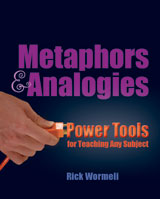Metaphors and Analogies: Power Tools for Teaching in Any Subject
Metaphors and Analogies: Power Tools for Teaching in Any Subject
By Rick Wormeli
(Stenhouse, 2009 – Learn more)
Metaphors and Analogies: Power Tools for Teaching in any Subject taught me more than any education book I’ve read in the last 10 years.
This book opens doorways into using metaphors and analogies as instructional tools that I never dreamed of. Rick Wormeli brings both his intellectual insight and his pragmatic understanding of daily classroom instruction to what is an often-overlooked but critical part of effective teaching.

Chapters 2 & 3 sketch out a plan for teaching students the format of metaphors and metaphorical thinking. Wormeli offers a way to critically evaluate metaphors for their usefulness and to engage students in that process. By internalizing the structure of this kind of analogical thinking, students gain a framework for looking at these comparisons and ultimately finding comparisons of their own.
Wormeli stresses that background knowledge is critical to understanding metaphors. This section of the book is loaded with ways to improve vocabulary and background for all students, including those in ELL programs.
I hadn’t considered how incorporating physical movement amplifies metaphors. It only makes sense now that I’ve read Chapter 6. Wormeli provides excellent examples to illustrate how to power-up critical thinking by adding dance moves, song or art. The following chapter adds visual metaphors. Wormeli explains how to attach an image to the concept you are introducing to make it long-lasting. I hadn’t seen a rebus since my childhood days of reading Highlights magazine, but Wormeli quickly helped me remember how powerfully those images were in making my own learning “sticky.”
Chapter 8 exposes the reader to scaffolds that students can use to create their own metaphors. At the same time, Wormeli reminds us that the kind of conversation that pushes deep thinking happens as students promote and defend their ideas. The chapter called Incubation Stage shows how to deepen and extend metaphors. One of the things I learned was that, at some point, a metaphor breaks down. As it breaks down students come to realize the comparison isn’t literal. It becomes a model they can use for thinking. Once they assimilate the model they will start connecting the “likeness” in unlike things between and within disciplines.
Finally, in understanding all this, students and teachers sharpen their analytical skills. They embrace abstract kinds of thinking and students are able to take their concrete knowledge to the next level –which is where every teacher wants to journey with our kids.
I heartily recommend this book for you and for a book club study group. So much practical advice. It’s worth every penny and more.
Marsha Ratzel teaches middle grades math and science in the Blue Valley (KS) School District, where she has also served as an instructional and technology coach. She blogs at Reflections of a Techie. This 2010 review is reposted from TLN Teacher Voices with Marsha’s permission.




































